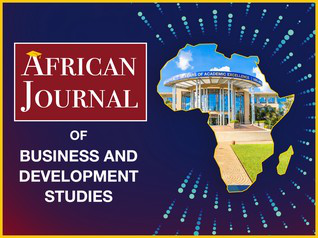Impact of Youth Academic-to-Industry Bridging Programs on Gender Sensitive Youth Socio-Economic Empowerment
DOI:
https://doi.org/10.70641/ajbds.v1i2.97Keywords:
Cybersecurity, Entrepreneurship, Gender Disparity, Impact, Youth UnemploymentAbstract
Student transition from academia to productive and professional workforce remains a critical challenge for youth employment. There exists an ongoing philosophical debate within academia regarding prioritization of lifelong learning over employability skills. This action research-based paper explores the impact of academic-to-industry bridging programs, with a focus on the Cyber Shujaa program. The program aimed to bridge academia-industry gap by providing transitional skills and capacity building that facilitates employment through job placements, entrepreneurship, and career advancement while promoting gender mainstreaming The research answers the question of whether academic to industry bridging programs help their beneficiaries attain meaningful employment and entrepreneurial opportunities. The research was informed by the Theory of Change which hypothesized that the program design features contribute to youth performance which in turn results into youth employment, gender participation and youth confidence, and ultimately influencing youth socio-economic empowerment. The study employed a descriptive correlation research design. The findings indicated that the program had a significant and positive impact on participants' employment readiness and technical skill application. Additionally, gender analysis revealed no statistically significant difference in employment outcomes, suggesting that the program’s gender mainstreaming approach successfully supported equitable career development. However, moderate satisfaction with employment preparation and placement suggested areas where enhancements could be made. Participants also reported a strong sense of purpose in pursuing cybersecurity careers, which positively correlated with their confidence levels. These findings underscored the importance of combining robust technical training with industry-based purpose-driven program components to enhance professional confidence, employability, and overall career satisfaction. This paper contributes to the ongoing dialogue on how to better equip young graduates for the demands of the industry, ultimately fostering a more inclusive, confident, and effective workforce.
References
Bell, D. N., & Blanchflower, D. G. (2009). Youth unemployment: Déjà vu? IZA Discussion Papers, No. 4705, Institute for the Study of Labor (IZA). DOI: https://doi.org/10.2139/ssrn.1545132
Blanchflower, D. G., & Oswald, A. J. (1998). What makes an entrepreneur? Journal of Labor Economics, 16(1), 26-60. DOI: https://doi.org/10.1086/209881
Cappellini, L., González-Velosa, C., & Rosas Shady, D. (2019). Vocational training in Latin America: Learning and job outcomes. Inter-American Development Bank.
Chakravarty, S., Lundberg, M., Nikolov, P., & Zenker, J. (2016). Vocational training programs and youth labor market outcomes: Evidence from Nepal. The World Bank Economic Review, 30(2), 318-345.
CyberSafe Foundation. (n.d.). CyberGirls – CyberSafe Foundation. Retrieved from https://cybersafefoundation.org
Eurofound. (2011). Youth unemployment and the risk of social exclusion. European Foundation for the Improvement of Living and Working Conditions.
Green, F. (2013). Youth entrepreneurship: A potential solution to youth unemployment. OECD Publishing.
Hardoy, I. (2005). Impact of Norwegian employment programs for youth: Findings from a follow-up survey. The Norwegian Labour and Welfare Administration.
Hirshleifer, S., McKenzie, D., Almeida, R. K., & Ridao-Cano, C. (2015). The impact of vocational training programs on youth employment: Evidence from Turkey. The World Bank. DOI: https://doi.org/10.1596/1813-9450-6807
Honorati, M. (2015). The impact of private sector internship and training on youth employment in Kenya. World Bank Policy Research Working Paper No. 7401. DOI: https://doi.org/10.1596/1813-9450-7404
Houle, J. N., Staff, J., Mortimer, J. T., Uggen, C., & Blackstone, A. (2015). The impact of the transition to adulthood on the mental health of young adults. Journal of Health and Social Behavior, 56(4), 458-474.
International Labour Organization. (2020). Global employment trends for youth 2020: Technology and the future of jobs. International Labour Organization.
Korkoyah, D. T., & Tasneem, A. (2014). The Economic Empowerment of Adolescent Girls and Young Women (EPAG) Project in Liberia: Midline Results Report. The World Bank.
Macharia, J. (2019). The Presidential Digital Talent Programme (PDTP): Fostering innovation among Kenya's youth. Kenya ICT Authority.
Michigan State University. (n.d.). Gender equality in academia: Closing the gap through visibility, viability, and value. Michigan State University.
Oreopoulos, P., von Wachter, T., & Heisz, A. (2008). The short- and long-term career effects of graduating in a recession: Hysteresis and training costs. American Economic Journal: Applied Economics, 2(1), 1-29. DOI: https://doi.org/10.1257/app.4.1.1
Peacock, L., & Irons, A. (2017). Gender disparity in the cybersecurity workforce: Challenges and opportunities. Journal of Cybersecurity, 3(2), 123-135.
Psilos, P., & Galloway, S. (2018). Entrepreneurship programs for youth: Strategies for increasing employability and business performance. IDRC.
Ryan, R. M., & Deci, E. L. (2000). Self-determination theory and the facilitation of intrinsic motivation, social development, and well-being. American Psychologist, 55(1), 68-78. DOI: https://doi.org/10.1037//0003-066X.55.1.68
SheHacks. (n.d.). Empowering women in cybersecurity. Retrieved from https://shehacks.com
Vogel, D. (2016). Closing the cybersecurity skills gap: Challenges and solutions. Cybersecurity Journal, 6(4), 21-35.
Wambalaba, et. al (2020). Gender Sensitive Implications of COVID-19 on Youth Agripreneurship Resilience https://idrc-crdi.ca/en/stories/coping-covid-19-researching-resilience-young-agripreneurs
Woodruff, T., (n.d.). Breaking the Glass Ceiling: Why Women in Science Must be Visible, Viable and Valuable. https://aapbridge.com/AAPBridge/groups/AAPBridge/stories/breaking-the-glass-ceiling-why-women-in-science-must-be-visible-viable-and-valuable
World Bank. (2013). Nepal: Adolescent Girls Employment Initiative (AGEI). World Bank Report.
Downloads
Published
How to Cite
Issue
Section
License
Copyright (c) 2025 Francis Wambalaba, Paula Musuva, Judy Ouma, Hope Nduta

This work is licensed under a Creative Commons Attribution-NonCommercial-ShareAlike 4.0 International License.





 This work is licensed under a
This work is licensed under a 